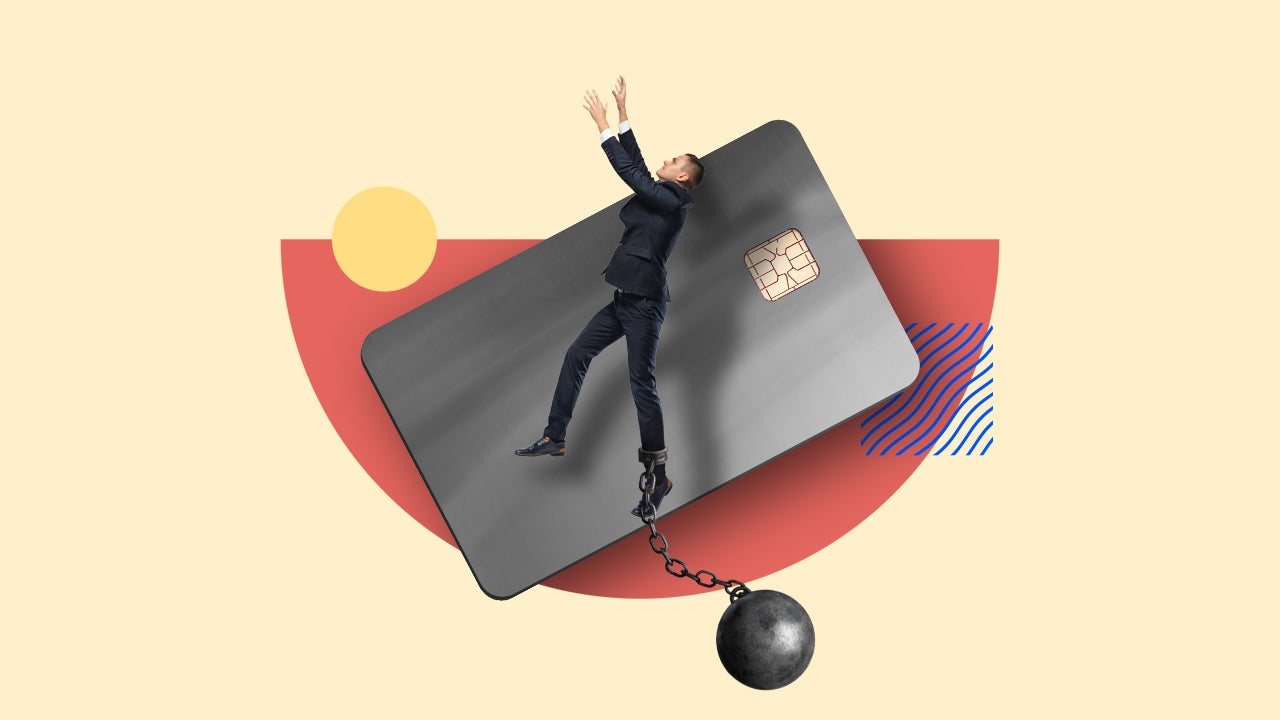How one young millennial is using the Chase Slate Edge to pay off debt

Jared Wilder, a 28-year-old SEO associate at Bankrate, spent the first part of his adult life accruing deep credit card debt to pay for college and life expenses. Roughly one year ago, he reached a point where he could no longer keep up with the minimum payments on his cards.
“I knew I was making a deal with the devil,” he says. “My minimum payments went from $120, to $270, to over $700. The math wasn’t working for me anymore. I felt I was about to go over the edge.”
Even with 44 percent of Americans in debt, debt repayment can be a confusing topic — especially if you’re carrying debt on multiple cards or loans. How do you compare interest rates? What’s that thing about snowballs versus avalanches? And how do you do a credit card balance transfer?
When Wilder’s minimum payments became unaffordable, he decided to tackle his debt using savvy credit products — and he used Bankrate calculators to crunch the numbers along the way. The following are the specific steps he took as he started paying off his debt.
1. He stopped ignoring his debt
Wilder says financial literacy wasn’t a focus in the Kentucky home where he grew up. He went to college with the aid of scholarships and federal loans, but still found himself having to put the occasional rent payments, meals and textbooks on a credit card. As a result, he graduated with nearly $9,000 in credit card debt.
Store credit cards, a few hospital bills and everyday wants and needs landed him in more than $30,000 in credit card debt five years later. He carried debt on five different cards, explaining his mentality as being, “I’m gonna spend this money now because I have to, and I’m gonna deal with the consequences later.”
Wilder wasn’t alone in this way of thinking. According to a Bankrate article on doom spending, almost half of Americans are in expensive credit card debt, and this may be due in part to stress-induced spending. Meanwhile, 47 percent of Americans say money negatively impacts their mental health, per Bankrate’s money and mental health survey.
The interest rates on Wilder’s cards ranged from 26.90 percent to 30.90 percent. That meant he was accruing $457 in credit card interest per month before beginning his repayment journey, and his minimum payments had skyrocketed to over $700 a month.
Of course, that number didn’t include his other necessary expenses like rent, groceries and gas. Wilder was in over his head.
“For many young adults, the cards are stacked against them when it comes to being able to afford day-to-day expenses, manage complex relationships like credit cards and other forms of consumer debt, and work in a job that makes enough money for you to make ends meet,” says Austin Kilgore, Analyst at Achieve. “Millennials and Gen Z are growing their debt at a much faster pace.”
When the consequences came — unaffordable minimum payments and a grim financial future — Wilder knew it was time to take action. He began looking into ways to manage debt with a balance transfer card and get a lower rate with a debt consolidation loan.
I’m really glad I didn’t ignore my debt any longer.
— Jared Wilder Red Ventures SEO Associate
2. He applied for a balance transfer card
Around this time, Wilder received an offer in the mail for the Chase Slate Edge℠ card*, which included a 0 percent intro APR for the first 21 months (normally 18 months). And although he compared several other balance transfer cards, he ultimately picked the Chase card.
A balance transfer transaction…can be a really powerful tool, especially when you get an introductory low- or no-interest period.
— Austin Kilgore Analyst for the Achieve Center for Consumer Insights
Rewards weren’t a factor he considered, as most balance transfer cards have limited reward options. Instead, he looked at the balance transfer fee (Chase Slate Edge charges $5 or 3 percent of the amount of each transfer, whichever is greater), the length of the intro offer and the accounts from which he could transfer balances.
Following his approval, Wilder transferred $2,750 of his credit card debt onto the card — as much as he could. With the 3 percent balance transfer fee, he paid an extra $82.50. To date, Wilder hasn’t made any repayments on the card itself. Instead, he’s using the interest-free period to buy himself time to repay his remaining debts.
Wilder currently has until September 2024 to carry a balance on the Chase Slate Edge card before it starts accruing interest. You can use Bankrate’s balance transfer calculator to find out how many months it will take you to pay off a balance transfer card based on the card’s terms.
“You have to understand the fine print of the interest rate terms and the promotional interest rate that you receive up front, and really understand what it’s going to take within your own budget to be able to be aggressive about paying down that debt when you have that low- or no-interest rate period,” Kilgore advises.
He continues: “Once that promotional period ends, if you’re still going to have debt to pay down, [be sure] that you can actually pay at the interest rate that will take effect after the promotion ends.”
According to Wilder, the Chase Slate Edge card has been easy to manage with the Chase app. And the one time he was a few days late on a payment, Chase didn’t charge him a penalty or kick in the card’s higher penalty APR. The card offered him the flexibility he needed to get his feet back under him.
3. He took out a personal loan
Since Wilder still had a large chunk of credit card debt he couldn’t move onto the balance transfer card, he took out a personal loan for $25,000. With a 19.90 percent interest rate, the monthly interest charges are lower on the loan than they were on his credit cards.
Wilder used the personal loan to pay off as much as he could on his credit card balances. Now, he’s repaying the personal loan in monthly installments of $587. The loan term is for 84 months, but he plans to pay it off sooner and keep his total interest paid below $10,000.
If you’re thinking about making a similar move, use Bankrate’s personal loan calculator to estimate your monthly payments as part of your overall debt repayment plan.
4. He used the avalanche method
To pay off the remainder of his credit card debt, Wilder is using the debt avalanche payment method. That involves paying off debt with the highest interest rate first — as opposed to the snowball method, which pays off the smallest debt balance first. The avalanche method can help you save money on interest in the long run.
Wilder’s repayment plan includes a monthly payment of $587 on his personal loan and around $1,400 in payments toward his high-interest credit card balances. Once all of his outstanding cards are paid off, he’ll begin paying off the balance on his balance transfer card. And after the balance transfer card is paid off, he plans to focus on paying back the personal loan more aggressively, since it has the lowest interest rate.
As a result of these changes, Wilder anticipates being credit card debt-free by October 2025.
“I sleep better, I feel better”: How debt repayment changed his life
Now that Wilder has been paying down his debt for close to a year, he hopes to be able to pay off his balance transfer card before the intro period ends and the card’s regular APR kicks in. His spending is under control, and he hasn’t added to his credit card debt.
“Financial stress was almost unbearable for most of my life,” he says. “Now it’s like complete night and day — I’m able to relax.”
I can look at my bank account and know for a fact that we’re gonna make it to the end of the year, and I don’t think I’ve ever been able to feel like that before. I sleep better, I feel better.— Jared Wilder, Red Ventures SEO Associate
His credit score has risen by 15 points, and his wife’s is up 40 points. After the debt is paid off, he dreams of opening up an American Express® Gold Card so they can travel with points.
“Once I fix the mistakes I made, I can actually get the real benefits of credit cards that I was never able to get because I was in such a hole,” he says.
Wilder’s also trying to turn the tide on financial literacy in his family. He’s been able to help his older sister — who’s in a similar boat — to tackle her own debt. And with his little sister in better financial standing, he’s also been able to help her find the right credit card to maximize rewards.
Kilgore says that debt consolidation can make it easier for people to repay debt, as opposed to juggling many accounts and transactions.
“People are struggling to keep track of everything,” Kilgore explains. “When you talk about balance transfers and debt consolidation personal loans, those can be really helpful in learning and enforcing new behaviors because you’re able to focus on fewer accounts…Mentally, it can help you stay motivated to pay down the debt.”
The bottom line
Credit card debt can feel impossible to navigate, but there are steps you can take to pay down your balances and improve your financial future. Use Bankrate’s debt payoff calculator to create your own repayment plan and estimate the interest and principal amounts you’ll pay. You can also get more balance transfer tips from Bankrate to help you on your payoff journey.
The information about the Chase Slate Edge has been collected independently by Bankrate. The card details have not been reviewed or approved by the issuer.
Why we ask for feedback Your feedback helps us improve our content and services. It takes less than a minute to complete.
Your responses are anonymous and will only be used for improving our website.






